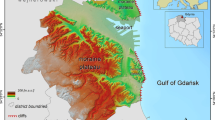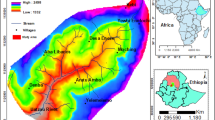Abstract
A study of landslides in Youngin, Janghung and Boeun, Korea, using the geographic information system (GIS) validates a spatial probabilistic model for landslide susceptibility analysis. Locations were identified from aerial photographs, satellite images and field surveys. Topography, soil-type, forest-cover and land-cover maps were constructed from spatial data sets. Landslide occurrence is influenced by 13 factors, evidence for which was extracted from the database with the frequency ratio of each factor computed. Landslide susceptibility maps use frequency ratios derived not only from data for each area but also ratios, one from the probabilistic model, calculated from the other two areas (nine maps in all) as a cross-check of method validity. For validation, analytical results were compared in each study area with actual landslide locations: Boeun based on its frequency ratio showed the best accuracy (82.49%) whereas Janghung based on the Boeun frequency ratio showed the worst (69.53%).






Similar content being viewed by others
References
Akgün A, Bulut F (2007) GIS-based landslide susceptibility for Arsin-Yomra (Trabzon, North Turkey) region. Environ Geol 51(8):1377–1387
Akgun A, Türk N (2010) Landslide susceptibility map** for Ayvalik (Western Turkey) and its vicinity by multicriteria decision analysis. Environ Earth Sci 61(3):595–611
Bai S-B, Wang J, Guo-Nian L, Zhou P-G, Hou S-S, Xu S-N (2010a) GIS-based logistic regression for landslide susceptibility map** of the Zhongxian segment in the three Gorges area, China. Geomorphology 115(1–2):23–31
Bai S, Lü G, Wang J, Zhou P, Ding L (2010b) GIS-based rare events logistic regression for landslide-susceptibility map** of Lianyungang, China. Environ Earth Sci. doi:10.1007/s12665-010-0509-3
Carson MA, Kirkby MJ (2009) Hillslope Form and Process, Cambridge University Press, London
Choi J, Oh H-J, Won J-S, Lee S (2010) Validation of an artificial neural network model for landslide susceptibility map**. Environ Earth Sci 60(3):473–483
Dahal R, Hasegawa S, Nonomura A, Yamanaka M, Masuda T, Nishino K (2008) GIS-based weights-of-evidence modelling of rainfall-induced landslides in small catchments for landslide susceptibility map**. Environ Geol 54(2):311–324
Das I, Sahoo S, van Westen C, Stein A, Hack R (2010) Landslide susceptibility assessment using logistic regression and its comparison with a rock mass classification system, along a road section in the northern Himalayas (India). Geomorphology 114(4):627–637
Gorsevski PV, Gessler PE, Boll J, Elliot WJ, Foltz RB (2006) Spatially and temporally distributed modeling of landslide susceptibility. Geomorphology 80(3–4):178–198
Guzzetti F, Carrara A, Cardinali M, Reichenbach P (1999) Landslide hazard evaluation: a review of current techniques and their application in a multi-scale study, Central Italy. Geomorphology 31(1–4):181–216
Kanungo DP, Arora MK, Gupta RP, Sarkar S (2005) GIS-based landslide hazard zonation using neuro-fuzzy weighting. Proceedings of 2nd Indian International Conference on Artificial Intelligence (IICAI-05), Pune 1222–1237
Kanungo DP, Arora MK, Sarkar S, Gupta RP (2006) A comparative study of conventional, ANN black box, fuzzy and combined neural and fuzzy weighting procedures for landslide susceptibility zonation in Darjeeling Himalayas. Eng Geol 85(3–4):347–366
Kanungo D, Arora M, Gupta R, Sarkar S (2008) Landslide risk assessment using concepts of danger pixels and fuzzy set theory in Darjeeling Himalayas. Landslides 5(4):407–416
Lee S (2005) Application of logistic regression model and its validation for landslide susceptibility map** using GIS and remote sensing data. Int J Remote Sens 26(7):1477–1491
Lee S (2007a) Application and verification of fuzzy algebraic operators to landslide susceptibility map**. Environ Geol 52(4):615–623
Lee S (2007b) Comparison of landslide susceptibility maps generated through multiple logistic regression for three test areas in Korea. Earth Surf Processes Landforms 32(14):2133–2148
Lee S, Evangelista DG (2006) Earthquake-induced landslide-susceptibility map** using an artificial neural network. Nat Hazards Earth Syst Sci 6(5):687–695
Lee S, Min K (2001) Statistical analysis of landslide susceptibility at Yongin, Korea. Environ Geol 40(9):1095–1113
Lee S, Pradhan B (2006) Probabilistic landslide hazards and risk map** on Penang Island, Malaysia. J Earth Syst Sci 115(6):661–672
Lee S, Ryu JH, Lee MJ, Won JS (2003) Use of an artificial neural network for analysis of the susceptibility to landslides at Boun, Korea. Environ Geol 44(7):820–833
Lee S, Ryu JH, Won JS, Park HJ (2004) Determination and application of the weights for landslide susceptibility map** using an artificial neural network. Eng Geol 71(3–4):289–302
Lee S, Ryu J-H, Lee M-J, Won J-S (2006) The application of artificial neural networks to landslide susceptibility map** at Janghung, Korea. Math Geol 38(2):199–220
Legorreta Paulin G, Bursik M (2009) Logisnet: a tool for multimethod, multiple soil layers slope stability analysis. Comput Geosci 35(5):1007–1016
Melchiorre C, Matteucci M, Azzoni A, Zanchi A (2008) Artificial neural networks and cluster analysis in landslide susceptibility zonation. Geomorphology 94(3–4):379–400
Miles SB, Keefer DK (2009) Evaluation of CAMEL—comprehensive areal model of earthquake-induced landslides. Eng Geol 104(1–2):1–15
Muthu K, Petrou M, Tarantino C, Blonda P (2008) Landslide possibility map** using fuzzy approaches. IEEE Trans Geosci Remote Sens 46(4):1253–1265
Nandi A, Shakoor A (2010) A GIS-based landslide susceptibility evaluation using bivariate and multivariate statistical analyses. Eng Geol 110(1–2):11–20
National Forest Research Institute (1991) Forest maps of Chungman 1:25,000 Published by National Forest Research Institute, Seoul, Korea
National Forest Research Institute (1992) Forest maps of GyeongGi 1:25,000 Published by National Forest Research Institute, Seoul, Korea
National Geographic Institute (1995) Topographic maps of Boeun and Janghun 1:5,000 Published by National Geographic Institute, Suwon, Korea
National Geographic Institute (2001) Topographic maps of Youngin 1:5,000 Published by National Geographic Institute, Suwon, Korea
National Institute of Agricultural Science and Technology (1973) Soil maps of 1:25,000 and 150,000 Published by National Institute of Agricultural Science and Technology, Suwon, Korea
Oh H-J, Lee S, Chotikasathien W, Kim C, Kwon J (2009) Predictive landslide susceptibility map** using spatial information in the Pechabun area of Thailand. Environ Geol 57(3):641–651
Ohlmacher GC (2007) Plan curvature and landslide probability in regions dominated by earth flows and earth slides. Eng Geol 91(2–4):117–134
Ozdemir A (2009) Landslide susceptibility map** of vicinity of Yaka Landslide (Gelendost, Turkey) using conditional probability approach in GIS. Environ Geol 57(7):1675–1686
Poudyal CP, Chang C, Oh HJ, Lee S (2010) Landslide susceptibility maps comparing frequency ratio and artificial neural networks: a case study from the Nepal Himalaya. Environ Earth Sci. doi: 10.1007/s12665-009-0426-5
Pradhan B, Lee S (2009) Landslide risk analysis using artificial neural network model focussing on different training sites. Int J Phys Sci 4(1):01–015
Pradhan B, Lee S (2010a) Delineation of landslide hazard areas on Penang Island, Malaysia, by using frequency ratio, logistic regression, and artificial neural network models. Environ Earth Sci 60(5):1037–1054
Pradhan B, Lee S (2010b) Landslide susceptibility assessment and factor effect analysis: backpropagation artificial neural networks and their comparison with frequency ratio and bivariate logistic regression modelling. Environ Modell Softw 25(6):747–759
Pradhan B, Lee S (2010c) Regional landslide susceptibility analysis using back-propagation neural network model at Cameron Highland, Malaysia. Landslides 7(1):13–30
Pradhan B, Lee S, Buchroithner MF (2010) A GIS-based back-propagation neural network model and its cross-application and validation for landslide susceptibility analyses. Comput, Environ Urban Syst 34(3):216–235
Ray RL, De Smedt F (2009) Slope stability analysis on a regional scale using GIS: a case study from Dhading, Nepal. Environ Geol 57(7):1603–1611
Regmi NR, Giardino JR, Vitek JD (2010) Modeling susceptibility to landslides using the weight of evidence approach: Western Colorado, USA. Geomorphology 115(1–2):172–187
Saha AK, Gupta RP, Sarkar I, Arora MK, Csaplovics E (2005) An approach for GIS-based statistical landslide susceptibility zonation-with a case study in the Himalayas. Landslides 2(1):61–69
Shou K, Chen Y, Liu H (2009) Hazard analysis of Li-shan landslide in Taiwan. Geomorphology 103(1):143–153
Vahidnia MH, Alesheikh AA, Alimohammadi A, Hosseinali F (2010) A GIS-based neuro-fuzzy procedure for integrating knowledge and data in landslide susceptibility map**. Comput Geosci 36(9):1101–1114
Wang Y-M, Elhag TMS (2008) An adaptive neuro-fuzzy inference system for bridge risk assessment. Expert Syst Appl 34(4):3099–3106
Yilmaz I (2009) Landslide susceptibility map** using frequency ratio, logistic regression, artificial neural networks and their comparison: A case study from Kat landslides (Tokat-Turkey). Comput Geosci 35(6):1125–1138
Yilmaz I (2010) Comparison of landslide susceptibility map** methodologies for Koyulhisar, Turkey: conditional probability, logistic regression, artificial neural networks, and support vector machine. Environ Earth Sci 61(4):821–836
Zhou CH, Lee CF, Li J, Xu ZW (2002) On the spatial relationship between landslides and causative factors on Lantau Island, Hong Kong. Geomorphology 43(3–4):197–207
Acknowledgments
This research was supported by the Basic Research Project of the Korea Institute of Geoscience and Mineral Resources (KIGAM) funded by the Ministry of Knowledge and Economy of Korea.
Author information
Authors and Affiliations
Corresponding author
Electronic supplementary material
Below is the link to the electronic supplementary material.
Rights and permissions
About this article
Cite this article
Oh, HJ., Lee, S. Cross-application used to validate landslide susceptibility maps using a probabilistic model from Korea. Environ Earth Sci 64, 395–409 (2011). https://doi.org/10.1007/s12665-010-0864-0
Received:
Accepted:
Published:
Issue Date:
DOI: https://doi.org/10.1007/s12665-010-0864-0




